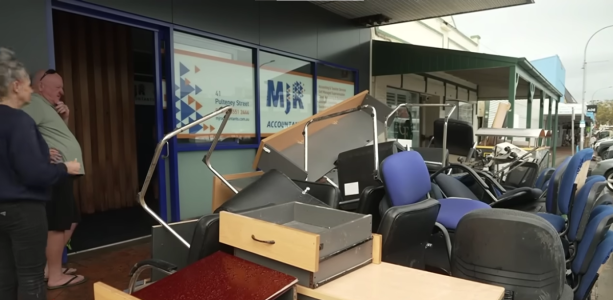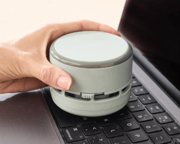You won’t believe what’s growing in homes after the floods
By
Maan
- Replies 9
Flood recovery is never easy—but for many Australians, it’s only the beginning of a much bigger problem.
As the waters recede, what’s left behind poses an invisible yet serious threat to homes and health alike.
One New South Wales town is now grappling with the aftermath—and the clock is ticking.
After the latest round of devastating floods in New South Wales, residents in the town of Glenthorne found themselves once again gutting their homes to prevent further loss.
Kelly Morgan, who previously restored her property after the 2021 floods, was forced to start over.
‘We have to get it off and dry it out before the mould sets in,’ she shared.
Her home had been completely overwhelmed by floodwaters, leaving her without a kitchen, laundry, power points or air conditioning.
‘My kitchen's just been ripped out. My laundry's been ripped out. Power points, air conditioners, everything. It's all gone.’
Now facing a year-long wait before her house becomes liveable again, Morgan relied on her daughter Sophie to help with the clean-up.
With no assistance from council or army personnel, the pair cleared mud, debris and attempted to salvage what they could.
They resorted to burning ruined belongings on the roadside due to long queues at local waste facilities.
‘We just don't have the time to try and get this mud out before it sets,’ Morgan said.
She was also dealing with rats: ‘We have big river rats.’
In the broader region, more than 32,000 people remained cut off by floodwaters, and the NSW State Emergency Service estimated around 10,000 properties had been affected.
The damage extended far beyond structural loss—residents now faced the risk of mould infestations as dampness, pooled water and poor airflow created the perfect conditions for growth.
Experts warned that mould could begin forming within just 24 hours.
Associate Professor Nicholas Osborne from the University of Queensland explained the health impacts of indoor mould.
‘Some moulds contain toxins some scientists feel may have health impacts,’ he said.
‘Others may induce allergic reactions, like hay fever.’
He added that mould could worsen health conditions such as asthma, rhinitis and chronic obstructive pulmonary disease.
‘The jury is still out on whether it contributes to individuals getting these diseases in the first place. In general, a healthy house is one that doesn’t have much mould.’
NSW Health advised flood-affected residents to ventilate their homes, dry out rooms quickly, and clean all surfaces with disinfectant or bleach while wearing protective gear.
The Victorian Department of Health also recommended disposing of items like carpet, mattresses and wallpaper if they could not be properly cleaned or dried.
Source: Youtube/SBS News
Mould wasn't only a concern for those hit by floods—high humidity could also lead to outbreaks in unaffected homes.
Residents were urged to identify moisture sources, clean visible mould carefully and put in place prevention strategies.
Despite the health risks, many affected homeowners found themselves without support from insurance providers.
Most policies excluded mould unless it stemmed from an insured event.
Morgan was vocal about the cost of flood coverage.
‘The flood insurance—it has to be addressed. It has to be looked at [by the government],’ she said.
‘Who has $70,000 a year to insure your property?’
A Compare the Market survey conducted in October 2024 found that 20.6 per cent of NSW adults had dealt with mould in the previous 12 months—above the national average of 18.7 per cent.
NSW also recorded the highest rate of dampness, with 11.7 per cent of respondents reporting issues compared to 9.9 per cent nationwide.
A 2022 report from Asthma Australia titled Homes, Health and Asthma in Australia estimated even higher figures, revealing that 34 per cent of over 5,000 respondents had experienced mould in their homes.
Aboriginal and Torres Strait Islander people were 2.3 times more likely to report mould and 6.5 times more likely to experience dampness.
Renters were also more vulnerable, being 1.9 times more likely than homeowners to report mould.
For people like Kelly Morgan, the future remained uncertain—not just because of flood damage, but due to the silent and spreading risk mould now posed.
In a previous story, we looked into the hidden reasons why some landlords refuse to address dangerous mould problems.
A leaked email revealed the shocking truth behind those ongoing delays.
If you’ve ever wondered why your rental issues go unresolved, you’ll want to read this.

With climate events becoming more extreme and frequent, how prepared do you think Australian homes really are for what comes after the flood? Let us know your thoughts in the comments.
As the waters recede, what’s left behind poses an invisible yet serious threat to homes and health alike.
One New South Wales town is now grappling with the aftermath—and the clock is ticking.
After the latest round of devastating floods in New South Wales, residents in the town of Glenthorne found themselves once again gutting their homes to prevent further loss.
Kelly Morgan, who previously restored her property after the 2021 floods, was forced to start over.
‘We have to get it off and dry it out before the mould sets in,’ she shared.
Her home had been completely overwhelmed by floodwaters, leaving her without a kitchen, laundry, power points or air conditioning.
‘My kitchen's just been ripped out. My laundry's been ripped out. Power points, air conditioners, everything. It's all gone.’
Now facing a year-long wait before her house becomes liveable again, Morgan relied on her daughter Sophie to help with the clean-up.
With no assistance from council or army personnel, the pair cleared mud, debris and attempted to salvage what they could.
They resorted to burning ruined belongings on the roadside due to long queues at local waste facilities.
‘We just don't have the time to try and get this mud out before it sets,’ Morgan said.
She was also dealing with rats: ‘We have big river rats.’
In the broader region, more than 32,000 people remained cut off by floodwaters, and the NSW State Emergency Service estimated around 10,000 properties had been affected.
The damage extended far beyond structural loss—residents now faced the risk of mould infestations as dampness, pooled water and poor airflow created the perfect conditions for growth.
Experts warned that mould could begin forming within just 24 hours.
Associate Professor Nicholas Osborne from the University of Queensland explained the health impacts of indoor mould.
‘Some moulds contain toxins some scientists feel may have health impacts,’ he said.
‘Others may induce allergic reactions, like hay fever.’
He added that mould could worsen health conditions such as asthma, rhinitis and chronic obstructive pulmonary disease.
‘The jury is still out on whether it contributes to individuals getting these diseases in the first place. In general, a healthy house is one that doesn’t have much mould.’
NSW Health advised flood-affected residents to ventilate their homes, dry out rooms quickly, and clean all surfaces with disinfectant or bleach while wearing protective gear.
The Victorian Department of Health also recommended disposing of items like carpet, mattresses and wallpaper if they could not be properly cleaned or dried.
Source: Youtube/SBS News
Mould wasn't only a concern for those hit by floods—high humidity could also lead to outbreaks in unaffected homes.
Residents were urged to identify moisture sources, clean visible mould carefully and put in place prevention strategies.
Despite the health risks, many affected homeowners found themselves without support from insurance providers.
Most policies excluded mould unless it stemmed from an insured event.
Morgan was vocal about the cost of flood coverage.
‘The flood insurance—it has to be addressed. It has to be looked at [by the government],’ she said.
‘Who has $70,000 a year to insure your property?’
A Compare the Market survey conducted in October 2024 found that 20.6 per cent of NSW adults had dealt with mould in the previous 12 months—above the national average of 18.7 per cent.
NSW also recorded the highest rate of dampness, with 11.7 per cent of respondents reporting issues compared to 9.9 per cent nationwide.
A 2022 report from Asthma Australia titled Homes, Health and Asthma in Australia estimated even higher figures, revealing that 34 per cent of over 5,000 respondents had experienced mould in their homes.
Aboriginal and Torres Strait Islander people were 2.3 times more likely to report mould and 6.5 times more likely to experience dampness.
Renters were also more vulnerable, being 1.9 times more likely than homeowners to report mould.
For people like Kelly Morgan, the future remained uncertain—not just because of flood damage, but due to the silent and spreading risk mould now posed.
In a previous story, we looked into the hidden reasons why some landlords refuse to address dangerous mould problems.
A leaked email revealed the shocking truth behind those ongoing delays.
If you’ve ever wondered why your rental issues go unresolved, you’ll want to read this.
Key Takeaways
- Kelly Morgan lost her home in the NSW floods and began urgent clean-up to stop mould.
- Thousands of homes were damaged or cut off, with mould posing serious health risks.
- Experts warned mould could form within 24 hours and worsen conditions like asthma.
- Insurance often doesn't cover mould, leaving residents like Morgan without financial support.
With climate events becoming more extreme and frequent, how prepared do you think Australian homes really are for what comes after the flood? Let us know your thoughts in the comments.
Last edited:








